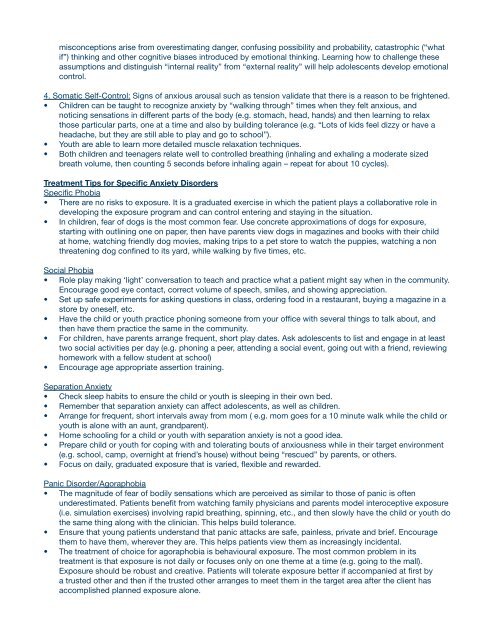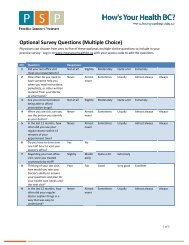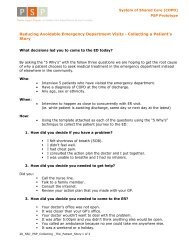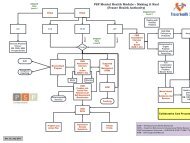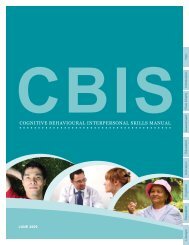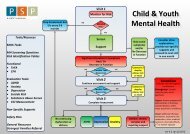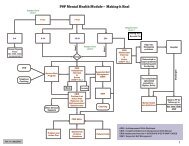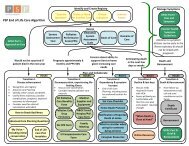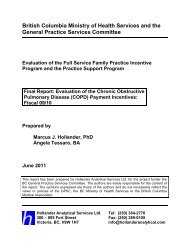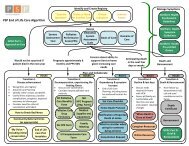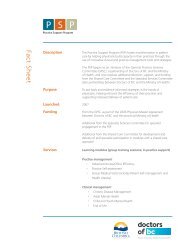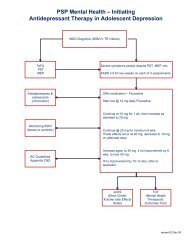Appendix B: Treatment of Anxiety Disorders in Children and ... - GPSC
Appendix B: Treatment of Anxiety Disorders in Children and ... - GPSC
Appendix B: Treatment of Anxiety Disorders in Children and ... - GPSC
Create successful ePaper yourself
Turn your PDF publications into a flip-book with our unique Google optimized e-Paper software.
misconceptions arise from overestimat<strong>in</strong>g danger, confus<strong>in</strong>g possibility <strong>and</strong> probability, catastrophic (“whatif”) th<strong>in</strong>k<strong>in</strong>g <strong>and</strong> other cognitive biases <strong>in</strong>troduced by emotional th<strong>in</strong>k<strong>in</strong>g. Learn<strong>in</strong>g how to challenge theseassumptions <strong>and</strong> dist<strong>in</strong>guish “<strong>in</strong>ternal reality” from “external reality” will help adolescents develop emotionalcontrol.4. Somatic Self-Control: Signs <strong>of</strong> anxious arousal such as tension validate that there is a reason to be frightened.• <strong>Children</strong> can be taught to recognize anxiety by “walk<strong>in</strong>g through” times when they felt anxious, <strong>and</strong>notic<strong>in</strong>g sensations <strong>in</strong> different parts <strong>of</strong> the body (e.g. stomach, head, h<strong>and</strong>s) <strong>and</strong> then learn<strong>in</strong>g to relaxthose particular parts, one at a time <strong>and</strong> also by build<strong>in</strong>g tolerance (e.g. “Lots <strong>of</strong> kids feel dizzy or have aheadache, but they are still able to play <strong>and</strong> go to school”).• Youth are able to learn more detailed muscle relaxation techniques.• Both children <strong>and</strong> teenagers relate well to controlled breath<strong>in</strong>g (<strong>in</strong>hal<strong>in</strong>g <strong>and</strong> exhal<strong>in</strong>g a moderate sizedbreath volume, then count<strong>in</strong>g 5 seconds before <strong>in</strong>hal<strong>in</strong>g aga<strong>in</strong> – repeat for about 10 cycles).<strong>Treatment</strong> Tips for Specific <strong>Anxiety</strong> <strong>Disorders</strong>Specific Phobia• There are no risks to exposure. It is a graduated exercise <strong>in</strong> which the patient plays a collaborative role <strong>in</strong>develop<strong>in</strong>g the exposure program <strong>and</strong> can control enter<strong>in</strong>g <strong>and</strong> stay<strong>in</strong>g <strong>in</strong> the situation.• In children, fear <strong>of</strong> dogs is the most common fear. Use concrete approximations <strong>of</strong> dogs for exposure,start<strong>in</strong>g with outl<strong>in</strong><strong>in</strong>g one on paper, then have parents view dogs <strong>in</strong> magaz<strong>in</strong>es <strong>and</strong> books with their childat home, watch<strong>in</strong>g friendly dog movies, mak<strong>in</strong>g trips to a pet store to watch the puppies, watch<strong>in</strong>g a nonthreaten<strong>in</strong>g dog conf<strong>in</strong>ed to its yard, while walk<strong>in</strong>g by five times, etc.Social Phobia• Role play mak<strong>in</strong>g ‘light’ conversation to teach <strong>and</strong> practice what a patient might say when <strong>in</strong> the community.Encourage good eye contact, correct volume <strong>of</strong> speech, smiles, <strong>and</strong> show<strong>in</strong>g appreciation.• Set up safe experiments for ask<strong>in</strong>g questions <strong>in</strong> class, order<strong>in</strong>g food <strong>in</strong> a restaurant, buy<strong>in</strong>g a magaz<strong>in</strong>e <strong>in</strong> astore by oneself, etc.• Have the child or youth practice phon<strong>in</strong>g someone from your <strong>of</strong>fice with several th<strong>in</strong>gs to talk about, <strong>and</strong>then have them practice the same <strong>in</strong> the community.• For children, have parents arrange frequent, short play dates. Ask adolescents to list <strong>and</strong> engage <strong>in</strong> at leasttwo social activities per day (e.g. phon<strong>in</strong>g a peer, attend<strong>in</strong>g a social event, go<strong>in</strong>g out with a friend, review<strong>in</strong>ghomework with a fellow student at school)• Encourage age appropriate assertion tra<strong>in</strong><strong>in</strong>g.Separation <strong>Anxiety</strong>• Check sleep habits to ensure the child or youth is sleep<strong>in</strong>g <strong>in</strong> their own bed.• Remember that separation anxiety can affect adolescents, as well as children.• Arrange for frequent, short <strong>in</strong>tervals away from mom ( e.g. mom goes for a 10 m<strong>in</strong>ute walk while the child oryouth is alone with an aunt, gr<strong>and</strong>parent).• Home school<strong>in</strong>g for a child or youth with separation anxiety is not a good idea.• Prepare child or youth for cop<strong>in</strong>g with <strong>and</strong> tolerat<strong>in</strong>g bouts <strong>of</strong> anxiousness while <strong>in</strong> their target environment(e.g. school, camp, overnight at friend’s house) without be<strong>in</strong>g “rescued” by parents, or others.• Focus on daily, graduated exposure that is varied, flexible <strong>and</strong> rewarded.Panic Disorder/Agoraphobia• The magnitude <strong>of</strong> fear <strong>of</strong> bodily sensations which are perceived as similar to those <strong>of</strong> panic is <strong>of</strong>tenunderestimated. Patients benefit from watch<strong>in</strong>g family physicians <strong>and</strong> parents model <strong>in</strong>teroceptive exposure(i.e. simulation exercises) <strong>in</strong>volv<strong>in</strong>g rapid breath<strong>in</strong>g, sp<strong>in</strong>n<strong>in</strong>g, etc., <strong>and</strong> then slowly have the child or youth dothe same th<strong>in</strong>g along with the cl<strong>in</strong>ician. This helps build tolerance.• Ensure that young patients underst<strong>and</strong> that panic attacks are safe, pa<strong>in</strong>less, private <strong>and</strong> brief. Encouragethem to have them, wherever they are. This helps patients view them as <strong>in</strong>creas<strong>in</strong>gly <strong>in</strong>cidental.• The treatment <strong>of</strong> choice for agoraphobia is behavioural exposure. The most common problem <strong>in</strong> itstreatment is that exposure is not daily or focuses only on one theme at a time (e.g. go<strong>in</strong>g to the mall).Exposure should be robust <strong>and</strong> creative. Patients will tolerate exposure better if accompanied at first bya trusted other <strong>and</strong> then if the trusted other arranges to meet them <strong>in</strong> the target area after the client hasaccomplished planned exposure alone.


